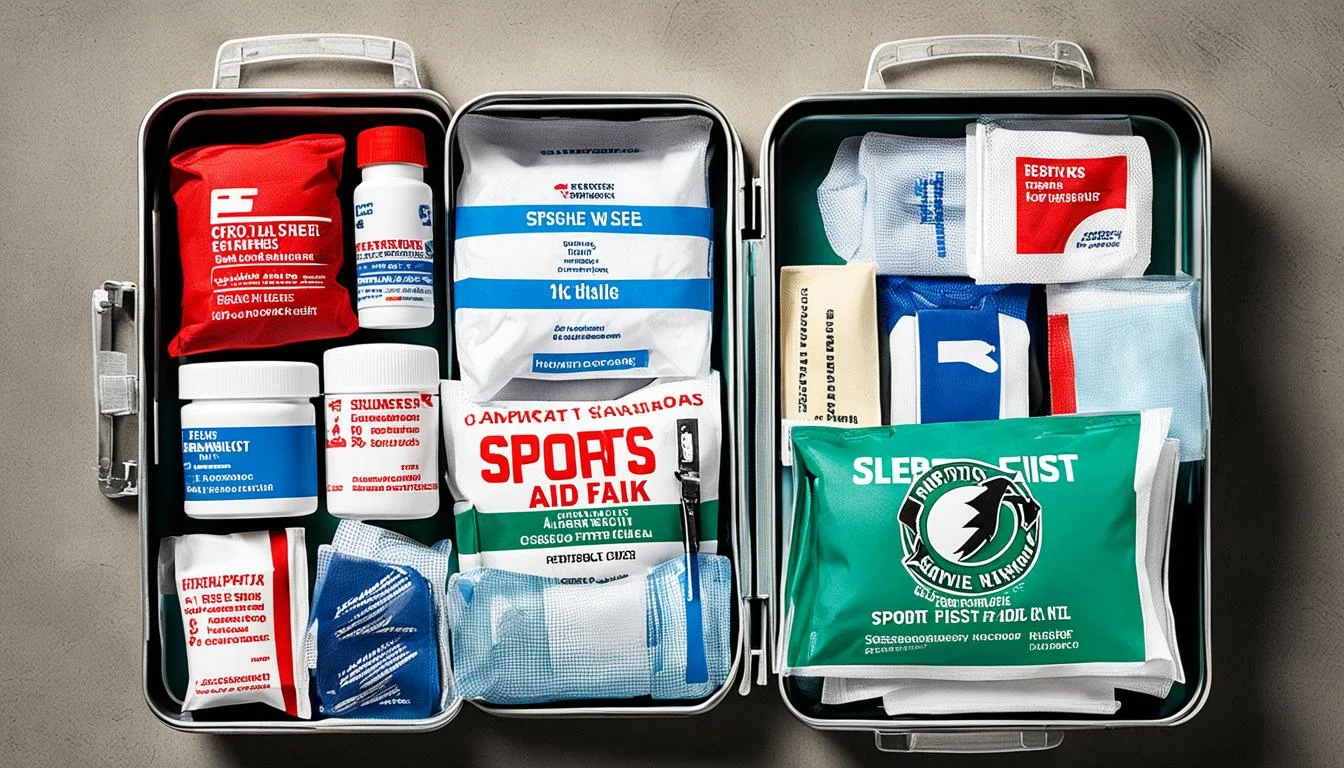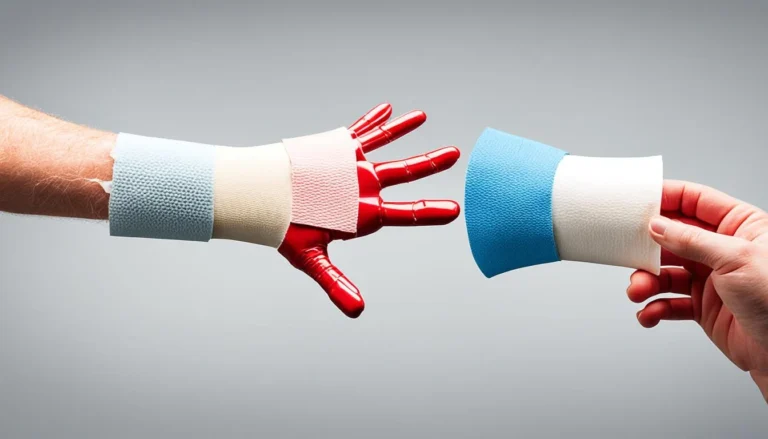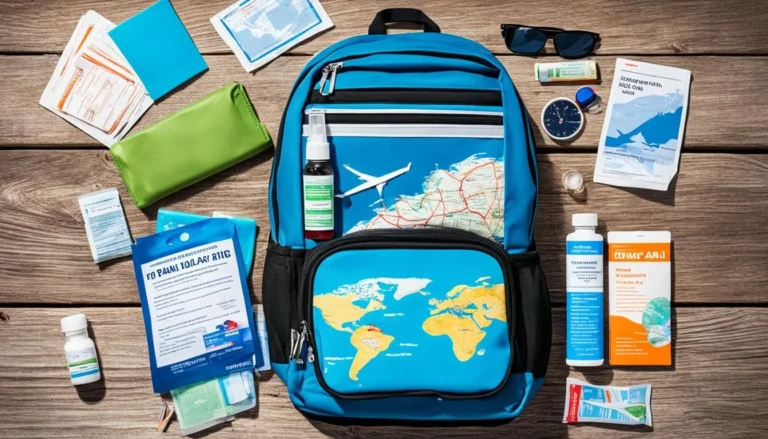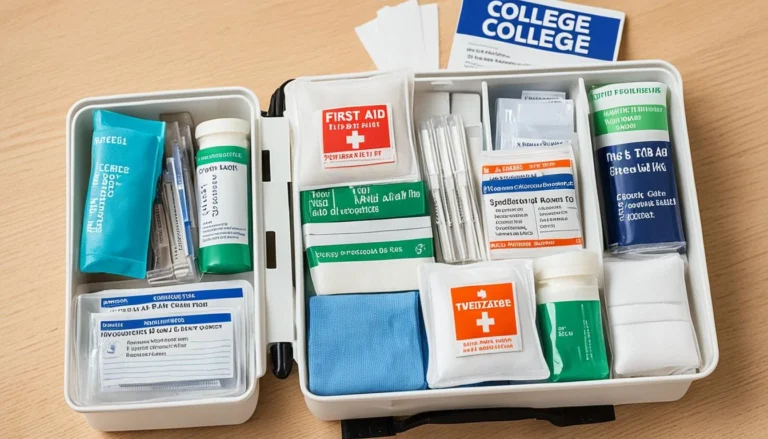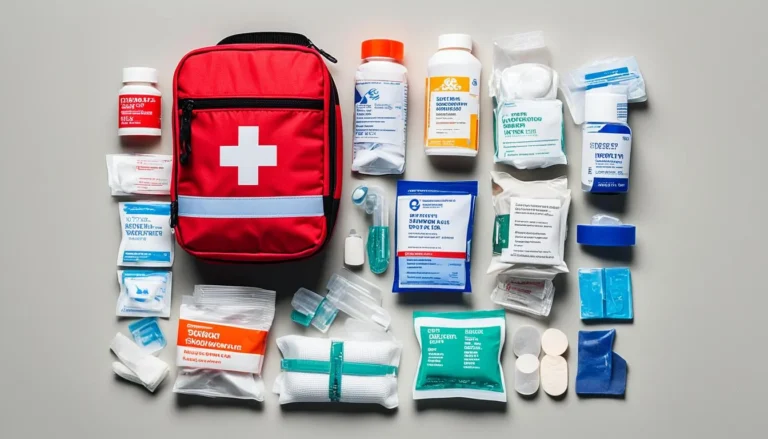20 Essential Items in a First Aid Box | Complete Guide
When minor troubles happen, a well-prepared first aid kit is a lifesaver. This guide tells you what to have in your kit. Keep it stocked with fresh supplies to be safe and helpful.
A good first aid kit is key for emergency preparedness. It has what you need for fast, effective help. Keep one at home, work, or in your bag for quick response to bumps, cuts, and more.
Key Takeaways
- A first aid box is essential for emergency preparedness and first aid supplies.
- Regular maintenance and checking of expiry dates ensure safety and effectiveness.
- The kit should be accessible at home, workplace, or during activities.
- Includes items for immediate care and injury management.
- Preparation is key for handling minor injuries and ensuring optimal health and safety.
The Importance of a Well-Stocked First Aid Box
A first aid box is vital for being ready for emergencies, no matter where you are. It should have all the essential items. This helps us treat injuries quickly and well. Also, it boosts safety all around.
The right items in a first aid kit mean you’re set for dealing with small accidents or big emergencies. Things like bandages, antiseptics, and basic medical tools help treat cuts and other issues fast. Keeping the kit up to date and full ensures everything is ready when needed. It’s a key rule for safety.
Workplaces need special first aid kits to meet their specific needs. These kits help follow health and safety rules. They make sure people can help fast when someone gets hurt. That’s a big part of keeping a safe place to work.
What Should an Effective First Aid Box Contain?
Making sure your first aid kit has the right things is key for fast and good emergency treatment. We will look at the essential items that should be in every kit to help with many medical cases.
Sterile Plasters and Bandages
Your kit needs to have sterile plasters and bandages of different sizes. They are vital for dealing with small cuts and scrapes. Using sterile ones helps keep wounds clean, preventing infections. So, these items are a must for any first aid kit.
Gauze Bandages
If the injury is more serious, you’ll need gauze bandages. They are important for proper wound care, covering and protecting wounds. It’s good to have plenty to handle a few injuries. Make sure you have both types, with adhesive and without.
Disinfectant Wipes
Disinfectant wipes or washes are very important. They help clean the wound before you put on a dressing. This is crucial for preventing infection control. Always keep lots of these wipes. This way, you can tackle different emergency treatment situations effectively.
What Are The 20 Items In First Aid Box?
A properly put together first aid box is key for quick emergency help. It should have key items for different medical needs. Make sure you pick the right essentials like dressings, bandages, meds, and tools for managing injuries. Here’s a list of the vital 20 components for a first aid box:
- Sterile plasters in assorted sizes
- Gauze dressings
- Disinfectant wipes
- Adhesive tape
- Antiseptic cream
- Scissors
- Thermometer
- Tweezers
- Burn cream
- Eyewash solution
- Cold packs
- Strips of sterile gauze
- Bandages for sprains
- Pain relief medications
- Hydrocortisone cream
- CPR face shield
- Alcohol-free cleansing wipes
- Disposable sterile gloves
- Small torch and spare batteries
- First aid manual
Every item in a first aid box helps a lot during medical emergencies. It’s important to have everything you might need. Check the box regularly to replace any items that may have expired or used up.
Sterile Eye Pads and Dressings
Eye injuries need quick and specific care to stop them getting worse. Always have sterile eye pads and dressings in your first aid kit. They are vital for effective treatment of eye injuries.

Quick ocular first aid means carefully removing any foreign items from the eye. Sterile eye pads absorb discharge and keep the area clean. Eye dressings cover the eye safely until a doctor can help.
Here’s how to use sterile eye pads and dressings:
- Wash hands well before touching eye pads.
- Use clean water or saline solution to gently clean around the eye if needed.
- Place the sterile eye pad softly over the sore eye, making sure it covers well.
- Use medical tape to fasten the dressing. It should be secure but not too tight.
- Get medical help as quickly as you can.
Having sterile eye pads and dressings in your kit makes it more ready to treat eye injuries. They ensure you can provide good ocular first aid when needed most.
Pain Relief Medications
Pain relief medicines are key in a first aid kit. They help right away with pain. And they make injuries or sickness feel less severe. These meds work for anything from small pains to allergic reactions. They keep everyone well during tough times.
Painkillers
Painkillers are essential, bringing fast pain relief. It’s smart to have ones for all ages, like for kids. Everyday painkillers like paracetamol and ibuprofen can tackle headaches and more. With these, you can deal with pain quickly and stop it from getting worse.
Antihistamine Cream
Antihistamine cream is vital for allergies. It eases skin issues and stops symptoms getting worse. Using it fast brings comfort and care right away in allergy episodes.
Here’s a look at pain relief and allergy treatment items for your kit:
| Item Name | Purpose | Common Use |
|---|---|---|
| Painkillers | Medication for pain | Headaches, muscle pain, dental pain |
| Antihistamine Cream | Allergic reaction treatment | Skin irritation, itching, swelling |
Thermometer and Cold/Hot Packs
A digital thermometer is a must for any first aid kit. It gives accurate temperatures quickly. This is critical for spotting fevers or infections early. For injury therapy, cold and hot packs are very useful. They help with new injuries by reducing swelling. And they can also make sore muscles feel better by using heat.
| Item | Purpose |
|---|---|
| Digital Thermometer | Accurate temperature measurement to monitor fevers and infections. |
| Cold Packs | Reduce inflammation and provide cooling relief for acute injuries. |
| Hot Packs | Soothes muscle aches and improves circulation in affected areas. |
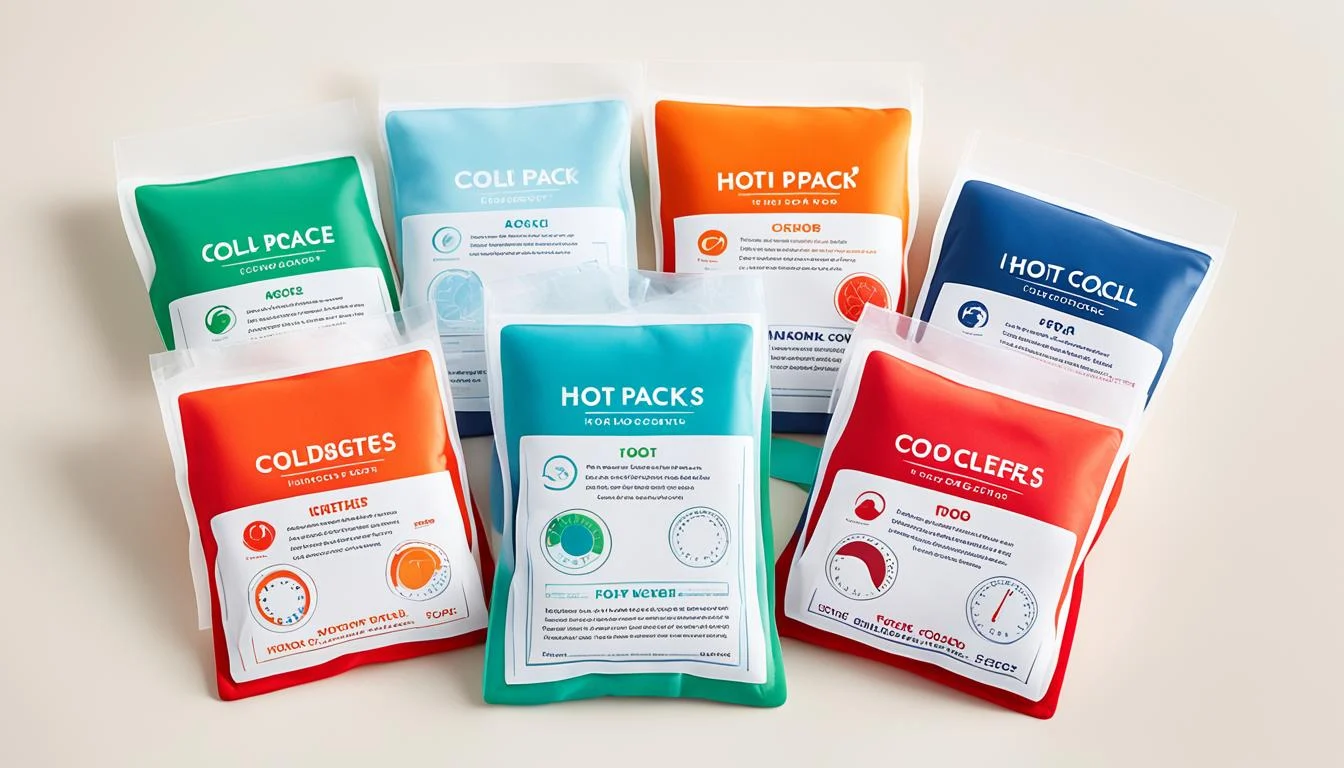
First Aid Guide and Instructions
One key part of a good first aid kit is a detailed first aid guide. Guides from places like St. John Ambulance give important first aid tips. They show you how to help in common emergencies, even if you’re not a doctor.
Having a first aid guide means you know what to do in many situations. They talk about small injuries like cuts, to big ones like severe bleeding. They also have info on how to do CPR, which is very important.
These guides boost your knowledge and make you feel more ready. When there’s an accident, having easy-to-understand steps can be a lifesaver. Doing first aid can be scary, but a good guide helps you stay calm and act fast.
The Importance of a First Aid Guide:
- Comprehensive Information: Covers lots of common injuries and health issues.
- Easy to Follow: Gives clear steps for a quick, right response.
- Portable: Small guides fit easily in any first aid kit.
Also, St. John Ambulance and other top groups update their guides often. This means you get the newest advice and tips. It’s good to have the latest info if you ever need to help someone.
A good first aid guide makes you ready for any surprise. A guide from St. John Ambulance in your kit means you’re not only ready for emergencies. You’ve got the basics to help and support anyone until experts arrive.
Basic Survival Gear
Having important survival gear in your first aid kit is vital. It’s needed in many emergency situations. These items add extra protection and usefulness when the unexpected happens.
Emergency Blanket
An emergency blanket is very important for survival. It keeps body heat in, helping with shock or cold. It’s small enough to fit in a first aid kit, always ready for use.
Small Scissors and Tweezers
Small scissors are a must for any survival kit. They cut tapes, dressings, and clothes to heal wounds better. Tweezers help take out splinters or tiny objects neatly, ready for further care.
Specialist Equipment
An advanced first aid box goes further than basic supplies. It includes specialised medical supplies for more complex injuries. These are picked carefully, considering many possible medical needs.
Splints are very important. They help in immobilising fractured limbs. This stops more harm and lessens pain until a doctor can help. Burn dressings are also key. They create a good, moist condition for wounds. This not only helps the healing but also lowers pain.
Then, there are self-adherent wraps that don’t have latex. They’re great for supporting injuries. This ensures everyone can get help without worrying about allergies.
| Specialist Equipment | Purpose |
|---|---|
| Splints | Immobilising fractures |
| Burn Dressings | Treating burns effectively |
| Latex-free Wraps | Secure, flexible support |
Having these specialised medical supplies makes a big difference. It boosts the effectiveness of an advanced first aid box. It ensures the care you give is right on point when tackling specific injuries.
Maintaining Your First Aid Box
To keep your first aid box useful, check it often. Make sure everything inside is ready for use. This way, your first aid kit upkeep keeps you ready for emergencies.
Expiry Dates
It’s crucial to watch the expiry dates on your first aid supplies. Sterile items and medicines lose their potency over time. To keep your kit effective, swap out things that are about to expire regularly. This ensures you’re using safe and potent products when needed.
Restocking Necessities
Regularly topping up your kit is key. After using items, like bandages or wipes, replace them to stay prepared. Keeping a restock list helps make this easier.
| Tasks | Frequency | Details |
|---|---|---|
| Checking Expiry Dates | Every 6 months | Ensure all items are within their usable period. |
| Replenishing Supplies | After every use | Restock used or low-quantity items. |
| Complete Inventory | Annually | Review the entire kit’s contents and replace as needed. |
Don’t forget to dispose of old or used products properly. This keeps everything in your kit safe to use. By keeping an eye on expiry dates and restocking, you make sure your first aid kit is a valuable emergency tool.
Selecting and Customising Your First Aid Kit
Choosing the right first aid kit is crucial for handling emergencies. A standard kit might not be perfect for your needs, be it at home, work, or outdoors. By customising, you ensure it meets specific needs for quick medical care.
Start by knowing what risks and needs you have. You should do a review to see what you might need. For example, think about injuries that could happen. If it’s for work, add things for both small injuries and bigger emergencies.
Make sure your kit is ready for all health needs. If someone has a bad allergy nearby, keep an EpiPen. For outdoor fans, think about things like cold packs or treatments for snake bites. This way, your kit is not only useful but can cover a wide range of health issues.
Remember, the best kits are made with careful thought and are regularly checked. By keeping your kit up to date, you’ll know you’re ready for whatever comes your way.

